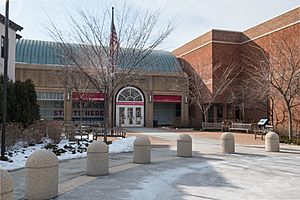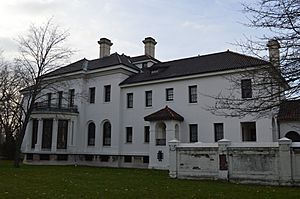Western Reserve Historical Society facts for kids

Entrance to the Cleveland History Center
|
|
| Established | 1867 |
|---|---|
| Location | Cleveland, Ohio, U.S. |
| Type | History museum |
The Western Reserve Historical Society (often called WRHS) is a special group in Cleveland, Ohio. It helps us learn about history! This society runs the Cleveland History Center, which is a group of museums in an area called University Circle.
WRHS started way back in 1867. This makes it the oldest cultural place in Northeast Ohio. The society focuses on the history of a region known as the Western Reserve. WRHS celebrated its 150th birthday in 2017.
Contents
Discovering Northeast Ohio's Past
The Western Reserve Historical Society is located in University Circle. This is a lively area in Cleveland known for its arts and culture. The Society collects and takes care of many historical items. These include old objects and important documents.
The main goal of WRHS is to "inspire people to discover the American experience." They do this by exploring the history of Northeast Ohio. They collect, protect, and share stories from all the people who lived in the Western Reserve. WRHS is a private group. It gets money from members, donations, and special grants.
A Journey Through Time: WRHS History
The Western Reserve & Northern Ohio Historical Society began in 1867. At first, it was part of the Cleveland Library Association. This library group started in 1848. The society wanted to record the history of Cleveland and the Western Reserve. They also wanted to cover the history of Ohio and the "Great West." Later, they focused more on Northeast Ohio. Their first president was Charles Whittlesey. He was a geologist and a historian.
The society first opened to the public in 1871. It was located on the third floor of the Society for Savings Bank. This spot is now where the Key Tower stands in downtown Cleveland. The collections grew so much that in 1892, they bought the entire bank building. That same year, the society became its own independent organization. It was no longer part of the Cleveland Library Association.
From 1898 to 1938, WRHS was located at E. 107th Street and Euclid Avenue.
WRHS moved to its current location in the late 1930s. Around the same time, they got the Hay-McKinney mansion. This beautiful house now holds part of the society's museum. In 1957, they also acquired the Jonathan Hale homestead. This farm in Bath, Ohio is now a living history museum.
In the 1960s, the society started to collect history from more groups of people. They began to record the stories of minority populations in Northeast Ohio. This included African-American, Jewish, Italian, and Irish communities. They also looked at the history of the local labor movement.
By the early 1980s, WRHS had become one of the largest private historical societies in the United States. In 1986, their library had about 250,000 books. It also held six million items like old letters and papers.
Exploring the Cleveland History Center
The main home of the Western Reserve Historical Society is in University Circle. It's called the "History Center." This center has several amazing places to visit:
- The Crawford Auto-Aviation Museum has over 150 old cars and airplanes. It's like a journey through transportation history!
- The Euclid Beach Park Grand Carousel is a classic ride. It was built in 1910. After the park closed, it was fully restored. It opened again on November 23, 2014.
- The History Museum has changing exhibits. These shows highlight local history. It also includes:
- The Hay-McKinney Mansion is a grand house built in 1911. It has fancy rooms from the early 1900s. Abram Garfield, the son of President James A. Garfield, designed it.
- The Bingham-Hanna House was built between 1916 and 1919. It's next to the Hay-McKinney property. Harry Payne Bingham built this 35-room house. Its design was by Walker & Gillette. The gardens were designed by Olmsted Brothers. It also features beautiful ironwork by Samuel Yellin.
- The Chisholm Halle Costume Wing holds over 30,000 clothes. These garments range from the late 1700s to today.
- The Library and Archives have over 20 million old papers and documents. You can use them for family research or to learn about any part of Northeast Ohio's history. They have the world's largest collection of items about the Shakers. Other big collections cover the Civil War and the car industry.
Life in the Past: Hale Farm and Village
Hale Farm & Village is located in Bath, Ohio. It's a "living history museum" run by WRHS. It shows what life was like in the 1800s. You can see how people farmed and made things. This includes glassblowing, pottery, spinning, and weaving.
Hale Farm's main goal is education. It brings the past to life. You can experience history firsthand. There are old buildings, demonstrations of crafts, and farm animals. There are also heritage gardens.
Hale Farm & Village shows rural life in the Western Reserve. It tells the story of three generations of the Hale family. Jonathan Hale arrived in 1810. His great-granddaughter, Clara Belle Ritchie, gave the farm to WRHS in 1956. She wanted it to be a museum. She hoped it would teach many people about the history and culture of the Western Reserve. In 1973, the Jonathan Hale Homestead was added to the National Register of Historic Places.
Hale Farm & Village is in the heart of the Cuyahoga Valley National Park. It's a great outdoor classroom. It has 32 historic buildings. There are also heritage farm animals, gardens, and crop fields. Staff in old costumes show how people lived. They also have programs and events all year. These explore the rich American experience in the Western Reserve.
Buildings at Hale Farm
- Jonathan Hale House (built 1825–1827); this was one of only two all-brick buildings in the Cuyahoga Valley when it was built.
- Jonathan Goldsmith House (built around 1830) was built for the William Peck Robinson family in Willoughby, Ohio. It was built by Jonathan Gillett Goldsmith.
- Fritch Log Cabin
- Log Smoke House
- Sugar House
- Sawmill
- The John A. McAlonan Carriage Manufactory
- The Stow House
- The Saltbox House
- The Jagger House
- Schoolhouse
- The Land Office
- The Mary Ann Sears Swetland Memorial Meetinghouse
- The Wade Law Office
- The Jonathan E. Herrick House
- The Aten Log Barn
Other Historic Places
- Shandy Hall is in Geneva, Ohio. It was built in 1815 by Col. Robert Harper. He was the son of Alexander Harper, who the township is named after. Shandy Hall shows what early life and architecture were like in the Western Reserve. Shandy Hall is currently being preserved. It is not open for public visits right now.
- Loghurst was built in 1805 in Canfield, Ohio. It is thought to be the oldest house in the Western Reserve. Loghurst is still part of the WRHS collection of historic buildings. Today, the Canfield Heritage Foundation takes care of the property. They also manage its public operations.
- The society also owned Lawnfield. This was President James A. Garfield's home in Mentor, Ohio. The Garfield family donated it in 1936. WRHS operated it until 2008. Then, it was given to the National Park Service.
See also
- List of historical societies in Ohio


